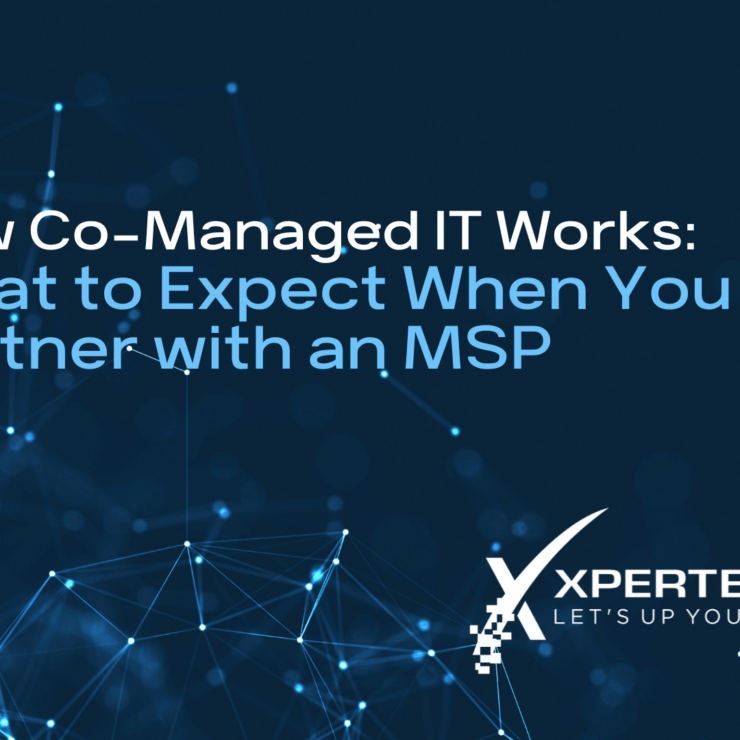How Co-Managed IT Works: What to Expect When You Partner with an MSP

If you’ve always relied on internal IT, it can be hard to picture how co-managed IT works, especially when you’re not outsourcing every aspect of IT management. How are responsibilities divided? Who handles what? What does day-to-day collaboration actually look like?
To answer those questions, you first need to understand that co-managed IT is a partnership. Your internal team stays in place, and together with your MSP, you determine how to divide responsibilities based on goals, capacity, and expertise. Here’s a glimpse of how we work with our co-managed IT clients to define roles and structure communication so that nothing falls through the cracks.
Key Takeaways
- Co-managed IT is a flexible partnership where internal IT teams and MSPs work together to meet business goals.
- Roles and responsibilities are divided based on internal capabilities, bandwidth, and strategic priorities.
- Shared tools and clear communication ensure transparency, accountability, and smooth day-to-day collaboration.
- MSPs provide structure and specialized expertise in areas like cybersecurity, automation, and strategic planning.
- The model adapts over time, allowing businesses to scale support and stay aligned as needs evolve.
Jump to Frequently Asked Questions about how co-managed IT services work.
Start by Aligning on Goals and Team Capabilities
Every co-managed IT relationship starts by understanding what your team does well and where they’re stretched. It’s equally important to clarify what your business is trying to achieve. When we’re getting started with a co-managed partnership, we sit down with your internal IT lead, CTO, or CIO to talk through questions like:
- What are your growth plans over the next 6, 12, or 24 months?
- How do you currently approach budgeting and planning for IT?
- What’s on your internal team’s plate now, and what would you rather they be doing?
This gives us a clear picture of your goals and helps define the right working model based on your internal strengths and where you need support.
Responsibilities Are Shared Based on Skills, Capacity, and Strategy
There’s no one-size-fits-all approach to co-managed IT. Some internal teams prefer to handle reactive support and respond to end-user requests. Others choose to offload day-to-day activities so they can focus on business systems or long-term projects.
The important thing is finding the right balance. That balance may shift over time, and that’s expected. We collaborate to make sure nothing gets dropped and everything aligns with your business goals. Some responsibilities, like patch management and firewall oversight, often stay with us to ensure consistency, accountability, and compliance. Even then, we operate transparently and keep your team informed.
Clear Communication and Shared Visibility Make Day-to-Day Work Smooth

Once responsibilities are defined and the working relationship is underway, collaboration becomes part of the routine. Your internal point of contact (or team) gets visibility into ticketing, status updates, and open issues. Depending on how we’re working together, they may also manage tickets directly alongside us.
What makes this work is consistent communication. We establish a cadence of check-ins, planning conversations, and updates so everyone stays aligned. When your priorities shift, we adjust.
Beyond the tasks assigned to us, we’re often working behind the scenes to improve workflows, build automations, and resolve issues before they impact your team.
Secure Tools and Guardrails Keep Everyone Accountable
Shared tools help both sides stay aligned without unnecessary complexity. You’ll have access to ticket tracking, documentation, reporting, and monitoring systems appropriate for your level of involvement.
For example, some teams want full access to service tickets and dashboards so they can work side-by-side with us. Others prefer a lighter touch, focusing on escalations, project progress, or reporting summaries.
Security is built in from the start. Everyone uses their own secure credentials, so access is controlled and activity is documented. That reduces confusion, supports compliance, and creates a clear record of who did what.
We also establish guardrails early for mission-critical systems like firewalls and backups. That way, there’s no ambiguity around responsibilities and no surprises when something needs attention.
Specialized Expertise Strengthens Your IT Operations

Co-managed IT helps you run a more effective and resilient IT operation. By partnering with XPERTECHS, you gain access to a broader bench of expertise than most companies can build internally.
- Your IT director can shift focus from ticket volume to business strategy.
- Your techs can stop firefighting and start improving workflows.
- You gain access to specialists in areas like cybersecurity, cloud, and automation without having to hire a full team.
- You’re no longer relying on one person or a small team to cover everything.
Related: What to Expect When Transitioning to Co-Managed IT
Let’s Build a Partnership That Works for You
Co-managed IT adds structure and expertise around your internal team so everything gets covered without stretching them thin. Whether you have one IT manager or a full department, we bring the tools, support, and strategy to help you get more from your technology.
Schedule a consultation to see what co-managed IT could look like for your organization.
Let’s up your game.
Frequently Asked Questions About Co-Managed IT Services
What does “co-managed IT” actually mean?
It’s a collaborative approach to IT management where your internal IT team works alongside a managed services provider (MSP). Responsibilities are shared based on your goals, team capacity, and areas where outside expertise adds value.
Will we lose control of our IT environment?
No. You stay in control. Co-managed IT is designed to enhance your team’s capabilities, not replace them. You’ll have visibility, input, and access every step of the way.
Who decides which tasks the MSP handles?
The division of responsibilities depends on your internal strengths and business priorities. We collaborate with you to identify gaps, set expectations, and ensure nothing falls through the cracks.
How do internal teams and the MSP stay aligned?
We use shared systems for tickets, documentation, and reporting. Regular check-ins and ongoing planning conversations keep both sides informed and in sync.
Is co-managed IT only for large companies?
No. Co-managed IT works well for any organization that has in-house IT staff but needs added capacity, specialized knowledge, or more structure to support growth.
What if our needs change over time?
The co-managed model is built to be flexible. As your business evolves, we adjust the working relationship to ensure continued alignment and support.